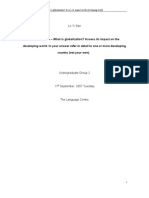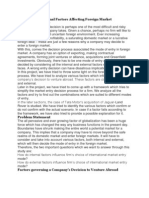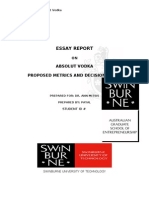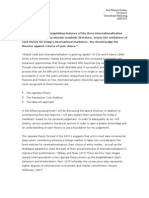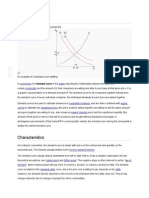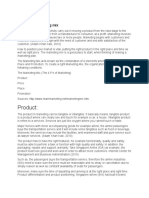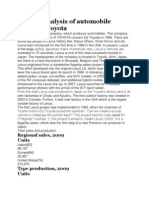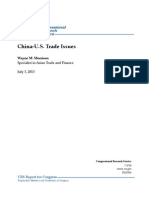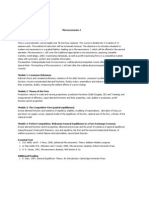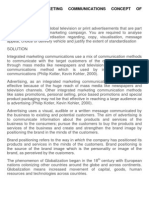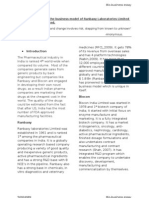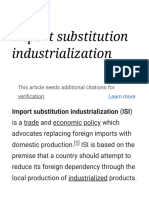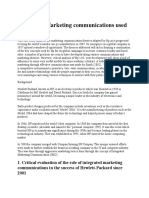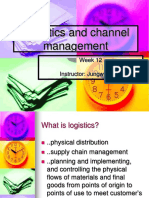Essay Chp7
Essay Chp7
Uploaded by
barrettm82a1Copyright:
Available Formats
Essay Chp7
Essay Chp7
Uploaded by
barrettm82a1Copyright
Available Formats
Share this document
Did you find this document useful?
Is this content inappropriate?
Copyright:
Available Formats
Essay Chp7
Essay Chp7
Uploaded by
barrettm82a1Copyright:
Available Formats
Chapter 7 Government Intervention in International Business GOVERNMENT INTERVENTION 1. In a short essay, describe two methods of government intervention.
What is the purpose of government intervention in international business? Answer Government intervention is often manifested as protectionism. Protectionism refers to national economic policies designed to restrict free trade and protect domestic industries from foreign competition. Protectionism often leads to two types of intervention: tariffs and nontariff barriers. A tariff is a tax imposed by government on imported products, effectively increasing cost of acquisition for the customer. A nontariff trade barrier, such as a quota, is a government policy, regulation, or procedure that impedes trade through means other than explicit tariffs. Governments intervene in trade and investment to achieve political, social, or economic objectives. Barriers are often applied to benefit specific interest groups, such as domestic firms, industries, and labor unions. A key rationale is to create jobs by protecting industries from foreign competition. Governments may also intervene to support home-grown industries or firms. In various ways, government intervention alters the competitive positions of companies and industries, and the status of citizens. (pp. 195-196; concept; Learning Objective 1; moderate; AACSB: Analytic Skills) RATIONALE FOR GOVERNMENT INTERVENTION 2. In a short essay, explain the four main motives for government intervention in international trade and investment activities. Provide examples to clarify each reason. Answer In the broadest terms, there are four main motives for government intervention. First, tariffs and other forms of intervention can generate much revenue. For example, Ghana and Sierra Leone generate more than 25 percent of total government revenue from tariffs. Second, intervention can ensure the safety, security, and welfare of citizens. For example, governments may pass laws to ensure a safe food supply and prevent sales of products that threaten public safety. Third, intervention can help a government pursue broad-based economic, political, or social objectives. For example, a government may enact policies that aim to increase national employment or promote economic growth. Fourth, intervention can help better serve the interests of the nations firms and industries. For example, a government may devise regulations to stimulate development of home-grown industries. (p. 196; concept; Learning Objective 2; moderate; AACSB: Analytic Skills)
120
3. What are the four major defensive motives for government intervention? In a short essay, provide a brief explanation of each motive. Answer a. Protecting the National Economy Proponents argue that firms in advanced economies cannot compete with those in developing countries that employ low-cost labor. Activists also call for trade barriers to curtail imports of cheap products, fearing that advanced economy manufacturers will be undersold, wages will fall, and homecountry jobs will be lost. Therefore, the argument goes, governments should impose trade barriers to block imports. b. Protecting Infant IndustriesIn an emerging industry, companies are often inexperienced and lack knowledge of the latest technologies. They may also lack the scale typical of larger competitors in established industries abroad. Therefore, an infant industry may need temporary protection from foreign competitors. Accordingly, governments can impose trade barriers on foreign imports, ensuring young firms a large share of the domestic market until they are strong enough to compete on their own. Protecting infant industries has allowed some countries to develop a modern industrial sector. c. Protecting National SecurityCountries impose trade restrictions on products viewed as critical to national defense and security, such as military technology and computers. Trade barriers can help maintain domestic productive capacity in security-related products, such as computers, weaponry, and certain transportation equipment. d. Protecting National Culture and IdentityCountries impose trade restrictions on products viewed as critical to national defense and security, such as military technology and computers. Trade barriers can help maintain domestic productive capacity in security-related products, such as computers, weaponry, and certain transportation equipment. (pp. 197-198; concept; Learning Objective 2; moderate; AACSB: Analytic Skills)
121
4. In a short essay describe the two offensive rationales for government intervention, that is, (i) establishing national strategic priorities and (ii) increasing employment. Answer The first offensive strategy involves establishing national strategic priorities. Government intervention sometimes aims to encourage the development of industries that bolster the nations economy. Countries with many high-tech or high value-adding industries such as information technology, pharmaceuticals, car manufacturing, and financial services create better jobs and higher tax revenues than economies based on low value-adding industries such as agriculture, textile manufacturing, and discount retailing. Accordingly, some governments for example, Germany, Japan, Norway, and South Korea devise policies that promote the development of relatively desirable industries. The second offensive strategy involves increasing employment. Governments often impose import barriers to protect employment in designated industries. By insulating domestic firms from foreign competition, national output is stimulated, leading to more jobs in the protected industries. The effect is usually strongest in import-intensive industries that employ much labor to produce products that are normally imported. (p. 198; concept; Learning Objective 2; moderate; AACSB: Analytic Skills) 5. What is the argument against protectionism? In a short essay, describe the negative effects to the economy when a government intervenes in international trade. Answer Critics counter that protectionism is at odds with the theory of comparative advantage, according to which nations should engage in more international trade, not less. Trade barriers interfere with country-specific specialization of labor. When countries specialize in the products that they can produce best and then trade for the rest, they perform better in the long run, delivering superior living standards to their citizens. Critics also charge that blocking imports reduces the availability and increases the cost of products sold in the home market. Industries cannot access all the input products they need. Finally, protection can trigger retaliation, whereby foreign governments impose their own trade barriers, reducing sales prospects for exporters. (p. 197; concept; Learning Objective 2; difficult; AACSB: Analytic Skills)
122
WHAT ARE THE INSTRUMENTS OF INTERVENTION? 6. In a short essay, explain the negative effects of high tariffs on international trade and business. How do high tariffs impact economic growth? Answer Just as people want to avoid paying taxes, firms try to avoid paying tariffs. Because tariffs have their greatest affect on imports, firms may enter countries via non-exporting entry modes, such as FDI. Governments collect less revenue from firms in the long run if tariffs are too high. In addition, high tariffs have been known to trigger smuggling. For instance, high duties on cigarettes in Canada have led to smuggling by those who transport contraband tobacco across the Great Lakes of the northern United States into the Canadian frontier. Because high tariffs inhibit free trade and economic growth, governments have tended to reduce tariffs over time. In fact, this was the primary goal of the General Agreement on Tariffs and Trade (GATT). Countries as diverse as Chile, Hungary, Turkey, and South Korea all have liberalized their previously protected markets, lowering trade barriers and subjecting themselves to greater competition from abroad. Developing economies have been lowering their tariff rates since the 1980s. Continued reductions in tariffs represent a major driver of market globalization. (pp. 200-201; concept; Learning Objective 3; moderate; AACSB: Analytic Skills) 7. What are quotas? In a short essay, explain the positive and negative effects of quotas. Provide an example of a product that has been imposed with a quota. Answer Quotas restrict the physical volume or value of products that firms can import into a country. In a classic type of quota, the U.S. government imposes an upper limit of roughly 2 million pounds on the total amount of sugar that can be imported into the United States each year. Sugar imports that exceed this level face a tariff of several cents per pound. The positive effect is that U.S. sugar producers are protected from cheaper imports, giving them a competitive edge over foreign sugar producers. The negative effect is that U.S. consumers and producers of certain types of products such as Hersheys and Coca-Cola pay more for sugar. It also means that companies that manufacture products containing sugar can save money by moving production to countries that do not impose quotas or tariffs on sugar. (p. 199; concept; Learning Objective 3; difficult; AACSB: Analytic Skills)
123
8. In a short essay, explain why agricultural subsidies have been implemented in Europe and the United States. What are the criticisms to these subsidies? Answer In Europe and the United States, governments provide agricultural subsidies to supplement the income of farmers and help manage the supply of agricultural commodities. The U.S. government grants subsidies for over two dozen commodities, including wheat, barley, cotton, milk, rice, peanuts, sugar, tobacco, and soybeans. In Europe, the Common Agricultural Policy (CAP) is a system of subsidies that represents about 40 percent of the European Union's budget, amounting to tens of billions of euros annually. The CAP and U.S. subsidies have been criticized for promoting unfair competition and high prices. The CAP and other subsidies tend to prevent developing countries from exporting their agricultural goods to the west. Subsidies encourage overproduction, and therefore lower food prices, which makes agricultural imports from developing countries less competitive. (p. 205; concept; Learning Objective 3; difficult; AACSB: Analytic Skills) 9. What are investment incentives? In a short essay, explain how these incentives are beneficial and provide an example of an investment incentive. Answer Governmental investment incentives are transfer payments or tax concessions made directly to individual foreign firms to entice them to invest in the country. For example, the cities of Austin, Texas and Albany, New York competed in 2006 for the chance to have the Korean manufacturer Samsung Electronics build a semiconductor plant in their regions. Austin offered $225 million worth of tax relief and other concessions in its successful bid to attract Samsung's $300 million plant, estimated to create nearly 1,000 new jobs locally. Investment incentives often help the economic development of a particular region or community. (p. 206; concept; Learning Objective 3; moderate; AACSB: Analytic Skills) GOVERNMENT INTERVENTION, ECONOMIC FREEDOM, AND ETHICAL CONCERNS 10. In a short essay, explain how government intervention in the form of subsidies can be utilized to help low-income groups. Provide an example of a nation in which this has occurred. Answer Government intervention can be used to offset harmful effects. For example, governments can use trade barriers to create or protect jobs that increase living standards for low-income groups. Governments provide subsidies that help counterbalance harmful consequences that disproportionately affect the poor. In Denmark, for example, globalization has affected thousands of workers whose jobs have been shifted to other countries with lower labor costs. The Danish government provides generous subsidies to the unemployed aimed at retraining workers to upgrade their job skills or find work in other fields. (p. 207; concept; Learning Objective 4; moderate; AACSB: Analytic Skills)
124
EVOLUTION OF GOVERNMENT INTERVENTION 11. In a short essay, explain how the GATT changed international trade. What four elements were initiated by the GATT? Answer In 1947, 23 nations signed the General Agreements on Tariffs and Trade (GATT), the first global effort to systematically reduce trade barriers worldwide. The organization proved extremely effective and resulted in the greatest global decline in trade barriers in history. The GATT initiated four key elements which changed international trade. First, GATT created a process to reduce tariffs through continuous negotiations among member nations. Second, GATT created an agency to serve as a watchdog over world trade. Third, GATT created a forum for resolving trade disputes. Finally, the GATT introduced the concept of most favored nation according to which each signatory nation agreed to extend the tariff reductions covered in a trade agreement with a trading partner to all other countries. Thus, a concession to one country became a concession to all. (p. 210; concept; Learning Objective 5; moderate; AACSB: Analytic Skills) 12. In a short essay, explain the difficulties faced by the WTO in establishing tariff standards for international services. How has the Doha Agenda affected the international service issues? Answer Services are largely intangible, so it is hard for governments to impose tariffs on them. Services do not pass through ports or customs stations. The product that a lawyer or an accountant offers is intangible knowledge and expertise. Thus, services have become subject to an array of nontariff trade barriers. Negotiations under the Doha Agenda have contributed to reducing trade and investment barriers in services. Under WTO rules, banks, insurance firms, tour operators, hotel chains, and transport companies increasingly enjoy the same trade and investment freedoms that originally applied only to products. A recent agreement significantly lowered international barriers in the telecommunications industry. Other multilateral agreements have covered computer software and financial services. (p. 211; concept; Learning Objective 5; difficult; AACSB: Analytic Skills)
125
HOW FIRMS SHOULD RESPOND TO GOVERNMENT INTERVENTION 13. How are investment-based entry strategies affected by tariffs? In a short essay, provide an example of an industry or firm that has minimized the burden of high tariffs. Answer Even investment-based entry is affected by tariffs if it requires importing raw materials and parts to manufacture finished products in the host country. Tariffs often vary with the form of an imported product. For example, U.S. food processor Conagra imports cooked tuna into the United States, which it then separates and converts into canned tuna, under the Bumble Bee brand. Conagra could have the tuna canned abroad, but the tariff on canned tuna is higher than the tariff on cooked tuna. Thus, Conagra cans the tuna in the U.S. as a strategy to minimize paying import tariffs. (pp. 212-213; concept; Learning Objective 6; difficult; AACSB: Analytic Skills) 14. In a short essay, explain how foreign trade zones work. How are FTZs utilized by firms? Answer A foreign trade zone is an area within countries that receives imported goods for assembly or other processing, and re-exports. Thus exported products receive preferential tariff treatment. Products brought into an FTZ are not subject to duties, taxes, or quotas until they, or the products made from them, enter into the non-FTZ commercial territory of the country where the FTZ is located. Firms use FTZs to assemble foreign dutiable materials and components into finished products, which are then re-exported. Alternatively, firms may use FTZs to manage inventory of parts, components, or finished products that the firm will need eventually at some other location. Some firms obtain FTZ status within their own physical facilities. In the United States, for example, Japanese carmakers store vehicles at the Port of Jacksonville, Florida. The cars remain in the Jacksonville FTZ without having to pay duties until they are shipped to U.S. dealerships. (p. 213; concept; Learning Objective 6; moderate; AACSB: Analytic Skills) 15. What is the importance of a products customs classification? In a short essay, explain how manufacturers can minimize tariffs through re-classification. Provide an example of an industry or firm which benefited from re-classification. Answer One approach for reducing exposure to trade barriers is to have exported products classified in the appropriate harmonized product code. Many products can be classified within two or more categories, each of which may imply a different tariff. For example, some telecommunications equipment can be classified as electric machinery, electronics, or measuring equipment. Manufacturers can minimize tariffs by ensuring that exported products are classified properly, ideally under a lower tariff code. Alternatively, the manufacturer might be able to modify the exported product in a way that helps minimize trade barriers. For example, South Korea faced a quota on the export of non-rubber footwear to the United States. By shifting manufacturing to rubber-soled shoes, Korean firms greatly increased their footwear exports. (pp. 213-214; concept; Learning Objective 6; moderate; AACSB: Analytic Skills) 126
127
You might also like
- Form ABCD FormatDocument5 pagesForm ABCD Formatsharique khan100% (6)
- Written Managerial Communication Assignment On Sands CorporationDocument9 pagesWritten Managerial Communication Assignment On Sands CorporationkmtNo ratings yet
- Economics Coursework Essay Report (UMEDKL-30-0) - 20020418 - Mohamed SannehDocument4 pagesEconomics Coursework Essay Report (UMEDKL-30-0) - 20020418 - Mohamed SannehfatouNo ratings yet
- Marketing Assignment Chapter 5Document5 pagesMarketing Assignment Chapter 5zeeocracy86% (7)
- Scope and Methods in Economics Harrod Roy-Páginas-1-16Document16 pagesScope and Methods in Economics Harrod Roy-Páginas-1-16genarospNo ratings yet
- FNCE401v7 Assignment 1Document8 pagesFNCE401v7 Assignment 1David Eaton50% (2)
- Basic Principles of GlobalizationDocument10 pagesBasic Principles of GlobalizationBarbara Zuñiga EscalanteNo ratings yet
- Business Capability Maps: Best Practices To DefineDocument1 pageBusiness Capability Maps: Best Practices To DefineJoão Tiago Martins GirãoNo ratings yet
- Pre Sessional EssayDocument9 pagesPre Sessional EssayYi San LoNo ratings yet
- Business Ethics EssayDocument6 pagesBusiness Ethics Essayapi-375666131No ratings yet
- Boundaries of Firm EssayDocument6 pagesBoundaries of Firm EssayRajvinder BhachuNo ratings yet
- BM629 CW3 Assignment Brief (DL) JMDocument13 pagesBM629 CW3 Assignment Brief (DL) JMArif KhanNo ratings yet
- Kentucky Fried Chicken Marketing PlanDocument8 pagesKentucky Fried Chicken Marketing PlanKristen NallanNo ratings yet
- Internal and External Factors Affecting Foreign Market Management EssayDocument10 pagesInternal and External Factors Affecting Foreign Market Management EssaySanjeev Thakur100% (1)
- Absolut Vodka MarketingDocument10 pagesAbsolut Vodka MarketingNihar ShahNo ratings yet
- Economics and Business Studies Command Terms For Writing Essays and Other QuestionsDocument4 pagesEconomics and Business Studies Command Terms For Writing Essays and Other QuestionsRei Diaz Apalla100% (1)
- Argumentative EssayDocument5 pagesArgumentative EssayWaqas CheemaNo ratings yet
- Advance Heterodox Economics - Lectures On ProductionDocument9 pagesAdvance Heterodox Economics - Lectures On Productionoscrend39No ratings yet
- Formulating Segmentation Targeting and Positioning StrategiesDocument15 pagesFormulating Segmentation Targeting and Positioning StrategiesBridgestone55100% (1)
- Case Study Johnson Johnson Marketing EssayDocument16 pagesCase Study Johnson Johnson Marketing EssayAdamZain788No ratings yet
- International Marketing - Assignment OneDocument7 pagesInternational Marketing - Assignment OneBelle TaylorNo ratings yet
- The Thomas Cook France Strategy On French Market Marketing EssayDocument19 pagesThe Thomas Cook France Strategy On French Market Marketing EssayHND Assignment HelpNo ratings yet
- Demand Curve: CharacteristicsDocument29 pagesDemand Curve: CharacteristicsAkhil VsNo ratings yet
- Coco Cola Malaysia IntroductionDocument3 pagesCoco Cola Malaysia IntroductionJagdesh SinghNo ratings yet
- School Essay On GlobalizationDocument10 pagesSchool Essay On GlobalizationCheow Xin YiNo ratings yet
- Strategic Resource MNG: Fahad UmarDocument19 pagesStrategic Resource MNG: Fahad UmarKankona Roy100% (1)
- Factors Behind The Brand Switching in Telecom IndustryDocument20 pagesFactors Behind The Brand Switching in Telecom IndustryRasheeq Rayhan0% (1)
- Coca Cola InternshipDocument3 pagesCoca Cola InternshipManik AroraNo ratings yet
- An Analysis and Case Study About Sony Corporation Marketing EssayDocument7 pagesAn Analysis and Case Study About Sony Corporation Marketing EssaySujitIndavarapuNo ratings yet
- International Business EssayDocument2 pagesInternational Business EssayBabafemi S. AkinkugbeNo ratings yet
- MN302 Essay Lecture 4Document4 pagesMN302 Essay Lecture 4Zain HussainNo ratings yet
- Economic Factors EssayDocument2 pagesEconomic Factors EssayAnonymous WvthCUNo ratings yet
- Brand Strategy Adopted by An Automobile Company VolkswagenDocument7 pagesBrand Strategy Adopted by An Automobile Company VolkswagenKrista MathewsNo ratings yet
- Marketing MixDocument7 pagesMarketing MixAroos AhmadNo ratings yet
- Pest AnanlysisDocument6 pagesPest AnanlysismzsaeedNo ratings yet
- China-US Trade IssuesDocument54 pagesChina-US Trade IssuesGabrielGaunyNo ratings yet
- Individual Reflective Essay For MarketingDocument2 pagesIndividual Reflective Essay For MarketingThasneem HaniffaNo ratings yet
- Distribution & Channel ManagementDocument4 pagesDistribution & Channel ManagementRosHan AwanNo ratings yet
- Apple Vs NokiaDocument9 pagesApple Vs NokiaCường MậtNo ratings yet
- Pestel Analysis of Indian Telecom Sector Economics EssayDocument9 pagesPestel Analysis of Indian Telecom Sector Economics EssayshanmukhaNo ratings yet
- A Study of Change ManagemenDocument5 pagesA Study of Change ManagemengeorgNo ratings yet
- Marketing Plan FinalDocument28 pagesMarketing Plan Finalapi-250564112No ratings yet
- Study of Competitive Rivalry in Indian Telecom SectorDocument18 pagesStudy of Competitive Rivalry in Indian Telecom Sectorarnabnitw100% (1)
- Challenges in International BusinessDocument4 pagesChallenges in International BusinessDum Dida DidaNo ratings yet
- MA Economics (Credit Based) Syllabus. Mumbai University Semester 1 and 2Document13 pagesMA Economics (Credit Based) Syllabus. Mumbai University Semester 1 and 2navagatNo ratings yet
- Integrated Marketing Communications Concept of McdonaldDocument9 pagesIntegrated Marketing Communications Concept of McdonaldKamlesh SoniwalNo ratings yet
- Lean or Agile or Lean and AgileDocument3 pagesLean or Agile or Lean and AgileHakanNo ratings yet
- Post Bureaucracy Vs Bureaucracy (Sample Essay - Business)Document6 pagesPost Bureaucracy Vs Bureaucracy (Sample Essay - Business)Leon Chen100% (1)
- QA Marketing and Enterprise Module Handbook - June 2016Document9 pagesQA Marketing and Enterprise Module Handbook - June 2016catalina_abrudeanNo ratings yet
- H1 Essay Example (Principles of Marketing)Document4 pagesH1 Essay Example (Principles of Marketing)May TangNo ratings yet
- International Business Report US Kitchen Cabinet Market Entry Analysis ForDocument24 pagesInternational Business Report US Kitchen Cabinet Market Entry Analysis ForTanja Vedda100% (1)
- Strategic HRM at Nestle Business EssayDocument8 pagesStrategic HRM at Nestle Business Essayaks0388No ratings yet
- Review Questions & Answers Macro All ChaptersDocument84 pagesReview Questions & Answers Macro All ChaptersHarjinder Pal Singh67% (3)
- Economics Syllabus PDFDocument10 pagesEconomics Syllabus PDFNolram LeuqarNo ratings yet
- Business Model of Ranbaxy and BioconDocument5 pagesBusiness Model of Ranbaxy and BioconRohit50% (2)
- Pestel Analysis of Indian Telecom Sector Economics EssayDocument10 pagesPestel Analysis of Indian Telecom Sector Economics Essaykarankasta17No ratings yet
- Marketing EssayDocument6 pagesMarketing EssaySara MillsNo ratings yet
- Entrepreneurship AssignmentDocument8 pagesEntrepreneurship AssignmentKumar Viswajeet SinghNo ratings yet
- Import Substitution Industrialization - WikipediaDocument79 pagesImport Substitution Industrialization - WikipediaOFFICIAL KIDLOVENo ratings yet
- Integrated Marketing Communications Used by HPDocument12 pagesIntegrated Marketing Communications Used by HPariaNo ratings yet
- The General Electric Mckinsey Matrix Marketing EssayDocument7 pagesThe General Electric Mckinsey Matrix Marketing EssayHND Assignment HelpNo ratings yet
- Mad About Trade: Why Main Street America Should Embrace GlobalizationFrom EverandMad About Trade: Why Main Street America Should Embrace GlobalizationNo ratings yet
- What To Expect When Co-Selling With DatabricksDocument31 pagesWhat To Expect When Co-Selling With DatabricksgakkinfinityNo ratings yet
- PRASOB ARAVIND - OriginalDocument5 pagesPRASOB ARAVIND - OriginalHamid SaifNo ratings yet
- Summer Internship Project Report On NIC ASIA BANK Surkhet NepalDocument61 pagesSummer Internship Project Report On NIC ASIA BANK Surkhet NepalAshish KumarNo ratings yet
- Position Paper About Graft and CorruptionDocument8 pagesPosition Paper About Graft and Corruptionjulito paquitNo ratings yet
- Chapter 7 Decentralization and Transfer PricingDocument34 pagesChapter 7 Decentralization and Transfer Pricingtamirat tadeseNo ratings yet
- 13 Accounting Cycle of A Service Business 2Document28 pages13 Accounting Cycle of A Service Business 2Ashley Judd Mallonga Beran60% (5)
- Chapter13 - Logistics and Channel ManagementDocument14 pagesChapter13 - Logistics and Channel ManagementKr RishiNo ratings yet
- Maharashtra State Board of Secondary and Higher Secondary Education, PuneDocument10 pagesMaharashtra State Board of Secondary and Higher Secondary Education, PuneKashyap PatelNo ratings yet
- SWOT of Arun IcecreamDocument14 pagesSWOT of Arun IcecreamCrbasera100% (1)
- Innovation Types & PhasesDocument18 pagesInnovation Types & Phasesmanishkanojia_100% (3)
- Swing Trading GuideDocument17 pagesSwing Trading GuideOtsile ModukaneleNo ratings yet
- Exercises Absorption and Variable CostingPAUL ANTHONY DE JESUSDocument4 pagesExercises Absorption and Variable CostingPAUL ANTHONY DE JESUSMeng DanNo ratings yet
- Financial Risk ManagementDocument48 pagesFinancial Risk ManagementmarifeNo ratings yet
- Proposal For Swine FatteningDocument8 pagesProposal For Swine FatteningJoy Boyles AbarquezNo ratings yet
- To Whom It May ConcernDocument12 pagesTo Whom It May ConcernGhazal WelchNo ratings yet
- Vendor Registration Form-TemplateDocument5 pagesVendor Registration Form-TemplateJayant Kumar Jha100% (1)
- Griffin Chapter 1 Notes SlideDocument28 pagesGriffin Chapter 1 Notes Slidetn_tylernguyenNo ratings yet
- The Age of Industrialisation: Before The Industrial RevolutionDocument1 pageThe Age of Industrialisation: Before The Industrial RevolutionAryan SinghNo ratings yet
- Supply Chain in FMCG SectorDocument12 pagesSupply Chain in FMCG SectorGirish BhangaleNo ratings yet
- Corporate Governance - Kingfisher CaseDocument23 pagesCorporate Governance - Kingfisher Caserashi100% (1)
- Business Process Management Journal: Article InformationDocument19 pagesBusiness Process Management Journal: Article InformationHarry WidodoNo ratings yet
- 2012 '000 2011 '000 Long-Term Liabilities Capital Employed Gearing RatioDocument5 pages2012 '000 2011 '000 Long-Term Liabilities Capital Employed Gearing Ratioolivia66wardNo ratings yet
- Finance - Wits UniversityDocument6 pagesFinance - Wits Universityhowm782No ratings yet
- Statement of Cash Flow - Kosinki Manufacturing CompanyDocument4 pagesStatement of Cash Flow - Kosinki Manufacturing CompanyRonnie Lloyd Javier100% (1)
- Upper Secondary Academy V Worksheet GSE 48 60 Shopping and ServicesDocument2 pagesUpper Secondary Academy V Worksheet GSE 48 60 Shopping and Serviceskarely0226No ratings yet
- Measuring InequalityDocument58 pagesMeasuring InequalitySafidy RmsNo ratings yet
- Michelin Case Potential AnswersDocument2 pagesMichelin Case Potential AnswersfidanNo ratings yet








